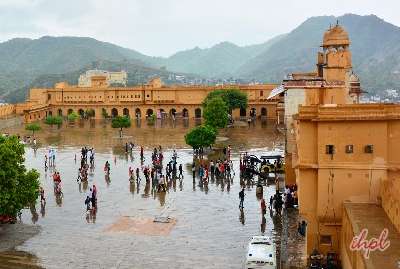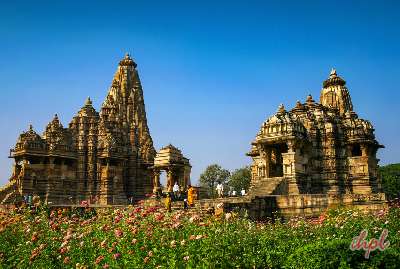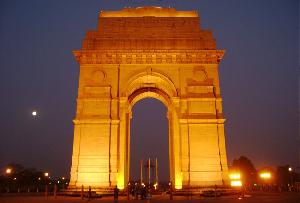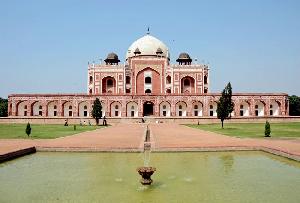Akshardham means the divine abode of God. It is revered as an eternal place of devotion, purity, and peace. Swaminarayan Akshardham complex aptly called as Akshardham Temple is one of the most important shrines among the Hindus. With its magnificent architecture, irresistible spiritual vibes, and a treasure of Indian culture, the Akshardham Temple is more than merely a site of devotion! This beautiful temple is dedicated to Swaminarayan, who was an Indian yogi and refined soul who existed during the 18th century. Holding its position for being the world’s largest Hindu temple complex in the Guinness Book of World Records the Akshardham temple is one of the top tourist places in Delhi. Visitors from various parts of the globe visit here to admire its rare beauty and soak in spirituality.
Experience beyond your imagination as this massive shrine ranks among the best tourist attractions to explore in Delhi. Scroll down, go through the details and get the best information, which you should know about the Akshardham Temple.
Checkout: Delhi Tour Packages
History of the Akshardham Temple
The seed of the temple was rooted by Shri Yogiji Maharaj’s, created by Pramukh Swami Maharaj, who was the fifth successor of the Lord Swaminarayan, and constructed by BAPS, Bochasanwasi Shri Akshar Purushottam Swaminarayan Sanstha. A total of about 90 acres of land was granted to build the temple by the Delhi and Uttar Pradesh governments. The 60 acres of land was granted by the Delhi Development Authority and 30 acres by Uttar Pradesh Government.
Located on the banks of River Yamuna, the construction of the Akshardham Temple was started in the second millennium year, 2000, and was opened to the people on 6th November 2005. The Akshardham temple was inaugurated by Pramukh Swami Maharaj in the presence of renowned personalities of India such as Dr. A.P.J. Abdul Kalam, L.K. Advani, B.L. Joshi, and Dr. Manmohan Singh – the Ex-Prime Minister of India. To bring the temple to this point more than 8000 volunteers participated and it took around 300,000,000 volunteer hours to achieve the shape of the temple.
The Magnificent Architecture
Words are not enough to describe this architectural masterpiece. At present, Akshardham Temple is the foremost attraction of Delhi city and without the temple, it is unlikely to imagine the city of Delhi. The temple is a fine example of classic Hindu architectural styles that were common in various parts of India during ancient and medieval times. Positioned in the core of the complex, the temple is built according to Vastu Shastra and Pancharatra Shastra. Each part of the Akshardham Temple complex is a composition of complex art that displays impeccable craftsmanship. The architecture of the temple represents India’s best culture and spiritual richness.
The main architectural highlights of this temple include:
- The main shrine is 141 feet in height, 316 feet in width, and 356 feet in length.
- The temple has been built using Italian Carrara marble and Rajasthani pink sandstone.
- The walls and ceilings of this temple are enhanced with images of deities, flowers, dancers, elephants (Gajendra), and carved motifs.
- There are also 20,000 statues of divine figures of India.
- The temple has more than 234 magnificently carved pillars.
- The temple has 20 quadrangle pinnacles and 9 ornate domes.
- The temple has 20,000 sculptures of spiritual personalities from India.
- The temple is surrounded by beautiful open gardens, a courtyard built in stepwell style, numerous water bodies, and other beautiful constructions.
Major Attractions
The concept of ‘Let noble thoughts come to us from all directions’ taken from Rig Veda is the basic concept of the temple. A visit to Akshardham Temple begins at the Ten Gates, indicating the ten directions described in Indian culture. They reflect the sentiments of accepting all that is auspicious and good from every direction. Additionally, exploring more sections of the temple will amaze and you would be left mesmerized. Scroll down to know what all awaits you in this spectacular temple.
- Gate of Devotion
The Gate of Devotion is also called the Bhakti Dwar, it is an embellished stone entrance that signifies the offering of pure devotion or bhakti towards the dual forms of God and his devotee. It has 208 elegantly carved pairs of Bhakta-Bhagwan bestowing their blessings on all. The bhakts (devotees) offer their bhakti to Akshar-Purushottam, Lakshmi-Narayan, Sita-Ram, Radha-Krishna, Parvati-Shiv, Nar-Narayan, and other gods.
This gate will take to another attraction – the Visitor Center, it welcomes every visitor with a display of bells to welcome all that is good. In the Visitor Center, you will find volunteers ready to help you in planning your time at the Akshardham complex. Also, the informational posters help visitors to know about the complex and its separate components.
- The Peacock Gate
Mayur Dwar or The Peacock Gate signifies the beauty and self-control in Indian culture. The Peacock, which is the national bird of India and is loved by people across the country. It also has a sacred position in the stories of Hindu mythology. Each of the two Mayur Dwars with the temple premises has 869 elegantly carved stone peacocks welcoming visitors with its charm and composure.
The Mayur Dwar will take you to a large marble replica of the holy footprints, or ‘charnarvind’, of Bhagwan Swaminarayan. The sixteen holy symbols which denote God’s feet can be seen in charnarvind, the holy footprints.
- Akshardham Mandir
A traditional temple, which is dedicated to Bhagwan Swaminarayan, who was an Indian Yogi. The temple reflects the beauty and spirituality of India’s ancient art, culture, and architecture. The temple has a unique construction to understand the complex temple check out the more details listed below:
1. The Facade
Any facade of a classical stone temple is known as a mandovar. The facade or mandovar of this temple has the largest and the most elegantly carved facade built in India in the last eight hundred years. The facade of the temple is 25 feet high, 611 feet long, and features 200 sculptured stones depicting rishis, sadhus, devotees, acharyas, and avatars.
2. The Inner Sanctum
Taking about the temple then the center attraction is the inner sanctum also called garbhagriha, which is the abode to Bhagwan Swaminarayan and his spiritual succession of gurus.
3. The Mandapams
Mandapams are the other notable things in the temple, the interior of the temple has nine mandapams (thematic spaces), which are filled with elegantly carved murtis (idols). The complex patterns and carvings of the mandapams incite reflection of God’s unimaginable grace and the beauty, which they inspire in the universe.
4. The Gajendra Peeth
The Gajendra Peeth presents tales and sagas of elephants with nature, humans, and God. You can observe the carvings of the elephant in a different position. This depiction of elephants is to understand these grand yet gentle animals, sharing messages of order, harmony, and kindness.
5. Narayan Peeth
According to Hindu custom, to pay respect to god a pradakshinas is performed, which is a dedicated walk-in clockwise direction encompassing the temple. The pradakshinas or round walk is done by various devotees, believing supreme power to be the core of life. To perform this tradition there are three 60 feet long bronze panels known as Narayan Peeth.
- Abhishek Mandap
Abhishek Mandap is the place, where Abhishek or the ritual bathing of a deity is done for the fulfillment of devotions. With the chanting of prayers and mantras, the devotee pours water over the deity. It is done for good health and prosperity. The devotee pours the holy water on the idol with the help of a small pot amidst the chanting of Sanskrit shlokas.
- Lotus Garden
The lotus garden is also known as Yogihriday Kamal, the major highlight of the temple is that it is built in a lotus shape and it was named in the honor of Yogiji Maharaj, who was the fourth divine successor of Bhagwan Swaminarayan. The theme of the garden is focused on its petals, each denoting – faith in God and morality, which dwells in every heart of the human and earning from everyone and doing good for all.
- Garden of India
Bharat Upvan or Garden of India is a beautiful garden inside the temple premises. It represents the brilliant natural and artistic ambiance through its green gardens and bronze statues of some great personalities of India.
- Narayan Sarovar
The Narayan Sarovar surrounds the Akshardham temple. The Sarovar is considered divine as it contains the holy waters of 151 rivers and lakes blessed by Bhagwan Swaminarayan. The Narayan savor contains water of Manasarovar, Pushkar Sarovar, Pampa Sarovar, Indradyumna Sarovar, Manikarnika Ghat, Prayag Triveni Sangam, River Kshipra, Rivers Ganga, River Yamuna, and from several other saintly water bodies. The major highlight is the outer wall of the temple, where 108 bronze gaumukhs (cow’s head) release water into the Sarovar from their mouth symbolizing 108 names of God.
The Best Way to Experience
As earlier stated – Akshardham Temple is more than merely a site of devotion! A visit to this beautiful place in Delhi has a myriad of things to experience, which is worth it for lifetime memories. The temple is a perfect blend of spirituality and recreation. Scroll down to know the best way to experience after visiting the temple.
- Exhibitions
The exhibits or exhibitions are represented in three large halls with the temple premises, each hall displays a unique presentation, which includes a source of knowledge, learning, and impulse combined with art, science, culture, and spirituality.
- Hall 1 – Hall of Values
Hall 1 represents human values through videos and robotic shows that portray the goals of nonviolence, justice, honesty, family unity, holiness, and respect.
- Hall 2 – Giant Screen Film
Hall 2 depicts the various regions of India on a huge screen, which includes the interesting story of an eleven-year-old yogi named Nilkanth, who travels the various regions of India.
- Hall 3 – Cultural Boat Ride
Enjoy a virtual voyage over 10,000 years of India’s remarkable heritage. Get to know about the findings and inventions of the rishi-scientists of India. Sail through the world’s first university of Takshashila to the caves of Ajanta-Ellora, and also find the contributions of India to humanity through several years.
- Water Show
Wait for the dusk and get ready to enjoy the best water show ever. The Sahaj Anand Water Show is a jaw-dropping presentation, which combines a variety of engaging media to bring to life a story from the Kena Upanishad. The video projections, vivid lights, underwater flames, and the live actor create an inspirational presentation. It is one of the best things to experience in the Akshardham temple. The magnificent musical fountain show of this beautiful temple is the center of attraction for the audiences.
Interesting Facts about the Akshardham Temple
- Akshardham temple is so vast that it takes at least 3 days to explore it in every aspect.
- There is a Kund known as Yagnapurush Kund, which is the world’s largest yagna kund.
- The temple is an ideal blend of India’s significant architectural techniques.
- The Garden of India or the Bharath Upavan is a botanical garden in itself as it boasts more than 300 rare species of plants and herbs.
- The temple looks more attractive at night.
- The temple receives over 1 lakh footfall weekly.
Timing and Ticket
- The temple remains open for visitors all day of the week except Monday.
Timings-
- First Entry – 9:30 AM
- Last Entry – 6:30 PM
- Exhibitions – 10:00 AM – 5:30 PM
Temple Entry
- Free
Ticket Fee for Exhibition and Water Show
Exhibition Only –
- Adult (12 years and above) – INR 170
- Senior Citizens(65 years and above) – INR 125
- Children (4 to 11 years) – INR 100
- Children (Below 4 years) – Free
Water Show –
- Adult (12 years and above) – INR 30
- Senior Citizens (65 years and above) – INR 30
- Children (4 to 11 years) – INR 20
- Children (Below 4 years) – Free
Note:
- The opening and closing time of the temple depends on the temple’s administration. Ticket prices may vary according to the temple’s administration policy.
- Management reserves the right of admission and any change to the schedules without prior notice.
Things to remember while visiting the temple:
- Do not carry any electronic items such as mobiles, cameras, pen drives, pager, etc. There is a cloakroom where you can submit your items.
- No bags are allowed within the temple complex.
- Outside food and drinks are not allowed inside the temple complex.
- No toys are allowed inside the temple complex.
- Use of tobacco and alcohol products is strictly prohibited inside the temple complex.
- No pets are allowed inside the temple complex.
- Do not use any slang or misbehave within the temple complex.
Best time to visit Akshardham Temple
The best time to visit the Akshardham temple, Delhi is from October to March when the weather is at its best. During this period you can easily explore the temple. To avoid a heavy rush it is suggested to visit the temple on weekdays as on weekends and public holidays the temple receives a huge crowd. If you are visiting Akshardham on the weekend be sure to keep at least one to two hours for being in the queue to enter the complex.
How to Reach Akshardham Temple
Reaching the Akshardham temple is not a hassle as the national capital of India has superb connectivity with other parts of the country.
By Air:
Indira Gandhi International airport around 21 km from the temple is the nearest airbase. After reaching the airport, travelers can hire taxis, or take the metro to reach the temple.
By Road:
You can easily reach Akshardham temple via road as Delhi has good connectivity by road to major cities of India like Agra, Jaipur, Shimla, Manali, and Dehradun, among others. You can enjoy ac, non-ac government bus services to reach the temple. The major bus terminals serving the city include Interstate Bus Terminals (ISBT) at Anand Vihar, Kashmiri Gate, and Sarai Kale Khan.
By Rail:
Delhi has 4 railway stations, which are New Delhi Railway Station (NDLS), Old Delhi Railway Station (DLI), Hazrat Nizamuddin Railway Station (NZM), and Anand Vihar Railway Terminal (ANVT). On reaching any of the stations you can hire a taxi or take bus services to reach the temple. The DMRC (Delhi Metro) is also well connected to all these railway stations. The nearest metro station to the temple is Akshardham metro station (on the Blue Line) is the simplest access to reach the temple.
Tourist Attractions near Akshardham Temple
- Sanjay Park (4 km)
- Millennium Park (7.5 km)
- Red Fort (7.2 km)
- India Gate (7.9 km)
- Madame Tussauds Delhi (8.2 km)
- Raj Ghat (8.6 km)
- Humayun’s Tomb (10 km)
- Shri Balaji Mandir (10.3 km)












